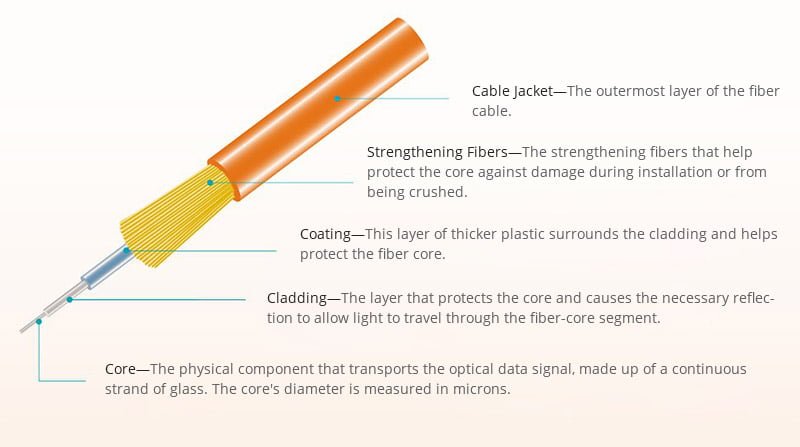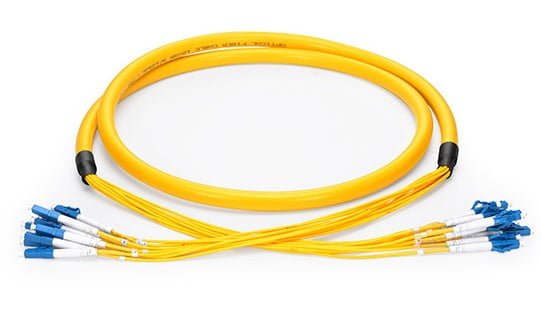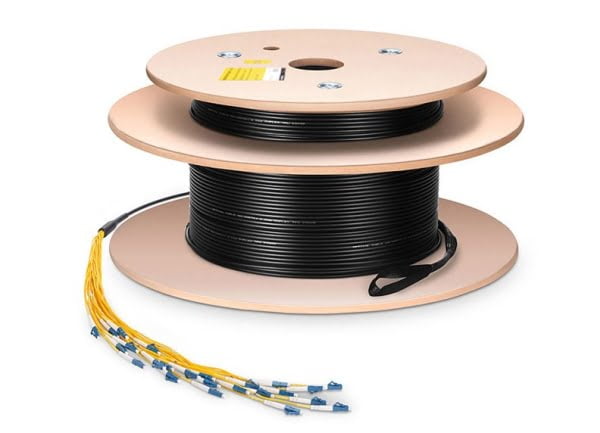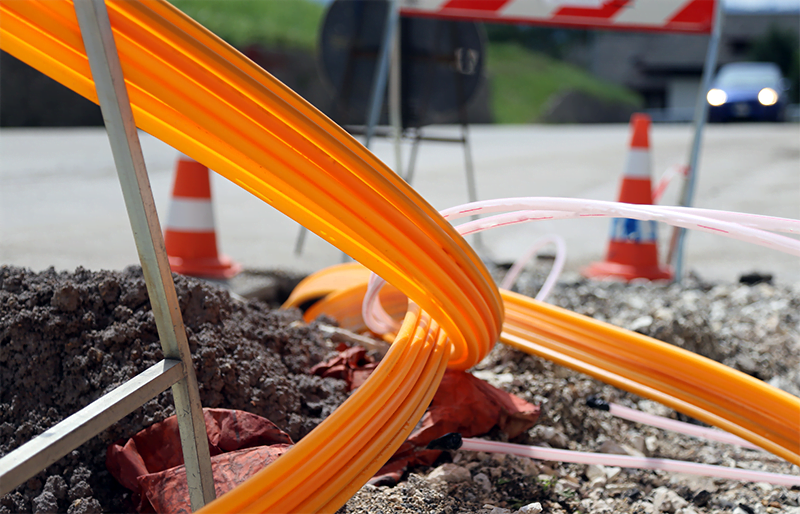Fiber Optic Cable Types and Installation
It is undeniable that our world today is built on the rapid transfer of massive amounts of information. Decades ago, data were transferred from a network device to another device through copper wires. But now, it has become apparent that fiber optic cables are steadily replacing copper wires as a better means for data transmission.
Inside a Fiber Optic Cable
The core of optical fibers can be plastic (used for very short distances), but most are made from glass. And glass optical cables are made from silica, which, in pure form, has a very low loss in infrared region of the optical spectrum. Designed for longer distance, very high-performance data networking and telecommunications, fiber optic cable uses light to transmit information while the copper wire uses electricity.
Internal Construction
A fiber optic cable is composed of the core, cladding, coating, strengthening fibers and cable jacket, with its core and cladding being the two main elements. The core is the light transmission area of the fiber. The cladding is the layer completely surrounding the core. Surrounding the cladding is usually another layer, called a coating.

Figure 1: The internal construction of an optical fiber
Working Principle
The principle of light transmission in an optical fiber is known as the total internal reflection, which states that when the angle of incidence exceeds a critical value, light cannot get out of the glass; instead, the light bounces back in. Based on this principle, light can move easily down the fiber-optic line. When this principle is applied to the construction of the fiber-optic strand, it is possible to transmit information down fiber optic cable in the form of light pulses. The core must be a very clear and pure material for the light or in most cases near infrared light (850nm, 1300nm and 1500nm). That’s why glass and plastic are the main materials for optical fibers.

Figure 2: The working principle of an optical fiber
Types of Fiber Optic Cable by Application
We’ve talked about fiber optic cable types from the perspective of fiber mode or material a lot in the past. Today we will give you a glimpse of fiber optic cable types from the perspective of their applications. According to the places where optical cables are deployed, they can be divided into indoor fiber optic cables and outdoor fiber optic cables.
Indoor Fiber Optic Cables
For fiber optic cables that are designed for indoor environments, they are generally versatile, convenient, and relatively inexpensive. It is common to find these cables in buildings, offices, and homes. Though indoor fiber optic cables experience less temperature and mechanical stress when compared with the fiber cables used outdoors, the key characteristic of indoor cables is fire-resistance.

Figure 3: Indoor multi-fiber breakout cable
Outdoor Fiber Optic Cables
There are several types of fiber optic cables for outdoor applications, such as underground fiber cables, direct buried fiber cables, and aerial fiber cables, each of which has its differences in design and characteristics.
Underground Fiber Cables
Underground fiber cables are generally pulled within a conduit which is buried underground, usually 1 to 2 meters deep, to reduce the possibility of being dug up. Lubricants are added in the outdoor cable design to reduce friction on high-pulling tension.
Direct Buried Fiber Cables
Direct buried cables are buried underground like underground cables, yet without conduit. Therefore, these cables must be able to withstand dust, pressure or rodent chewing. Compared with the underground cables with conduits, direct buried cables are more solid.
Aerial Fiber Cables
Aerial cables are placed from poles or pylons or mounted on buildings. The deployment environment protects aerial cables from man-made damage or theft but increases the risk of being destructed by natural elements such as storm, wind, and ice. In Aerial Fiber Optic Cables Tutorial, information on aerial fiber optic cable types and tips on aerial cable installation is covered.
Submarine/Underwater Fiber Cables
As the name suggests, the submarine or underwater cables must have the protection against water and moisture as the result of the specific outdoor environments they are placed. Considering that factor, most of the underwater cables now build with a gel or absorbent powder or tape, which generally applies to loose tubes or ribbon cables.
Though indoor cables and outdoor fiber optic cables have so many differences, nowadays there are some cables applicable for both indoor and outdoor applications, which are designed to meet the rigorous environment of the outdoors but also meet the flame rating requirements applied indoors.

Figure 4: Indoor/outdoor fiber cable assembly
The Installation of Fiber Optic Cable
With the features of high bandwidth, low power loss, light weight and so on, fiber optic cables have gained popularity among network service providers and are widely adopted for today’s network cabling. Although with so many advantages, it doesn’t mean that fiber cable installation needs no care. Since this post Fiber Optic Cable Installation Tips have listed the main installation tips for reference, the next part will offer you some targeted advice about installing in different places such as runs in the conduit, above ceilings and below floors, runs in cable trays and risers.

Figure 5: Fiber optic cable installation
Conduit Cabling
Conduit cabling can be used indoors in walls or ceilings and outdoors especially for underground cables. It’s inflexible for conduit installation for a big difficulty to make moves, adds and changes. When pulling cable in conduit, all transition points should be kept smooth. Try to leave an additional piece of conduit outside of the transition to keep the cable from resting on a sharp edge. Or you can use inner duct or flexible conduit to keep cables from damage. You also need pull boxes for fishing the run and looping the cable for the next length of conduit. To ease the installation, fish tapes or pull cords should always be placed in the conduit. You can see more detailed contents in Duct Installation of Fiber Optic Cable.
Note: The inside radius of conduit bends should be at least 10 times the diameter of the cable. Conduit runs should be limited to 100 feet, with no more than two 90-degree bends between pull points or boxes.
Dropped Ceilings and Raised Floors Cabling
Installation in drop ceilings or raised floors may be the easiest. Suspended ceilings consist of low-weight panels supported by a system of metal frames or grids attached to the ceiling. Usually these panels can be easily moved away from the grid when they are pushed up. Then more space can be left for other equipment installation. Fiber cables in these spaces should be well supported and organized. You are suggested to use some tools for easy fiber optic cable management like trays, J-hooks and cable ties.
Trays Cabling
Cables trays or ladder racks provide a convenient, safe, efficient location for optical fiber cable installation. Trays can be installed in ceilings, under floors and in riser shafts. Trays can provide good support and certain protection for cables. But you should still notice that cables may also suffer from stress. When running the fiber cables in the trays, better avoid as much tension, crushing and bending as possible. Make sure the cabling routes are away from sharp turns, snags (sometimes from other cables) and rough surfaces. Try not to pull cable under or between heavier cable or multiple cables that may create huge stress. It’s also true to moves and adds of fiber cables. Do not forget to secure the cable to the tray with cables ties to avoid damage during changes, and do this every three feet.
Riser Cabling
For vertical cabling in risers, if possible, at least use the cable rated OFNR. When pulling cables vertically, use some device to support the cable without crushing the core. Cables should be supported with cable ties in wiring closet. And begin the installation from the top, making it easier comparing to pulling cable from the opposite direction. Maybe handling procedures of optical fiber cables produced by different manufacturers are different. So follow the manufacturer’s instructions at first.
Summary
Looking back over two decades, copper wires ruled while fiber was first introduced. Today things change. Obviously fiber is so powerful that without any doubt it will carry the majority of the traffic. Only fiber optic cable, with its long reach, reliability, space savings, immunity to interference and relatively low cost, can help both public and enterprise operators control their budgets and deliver high-quality services at even faster speeds.
